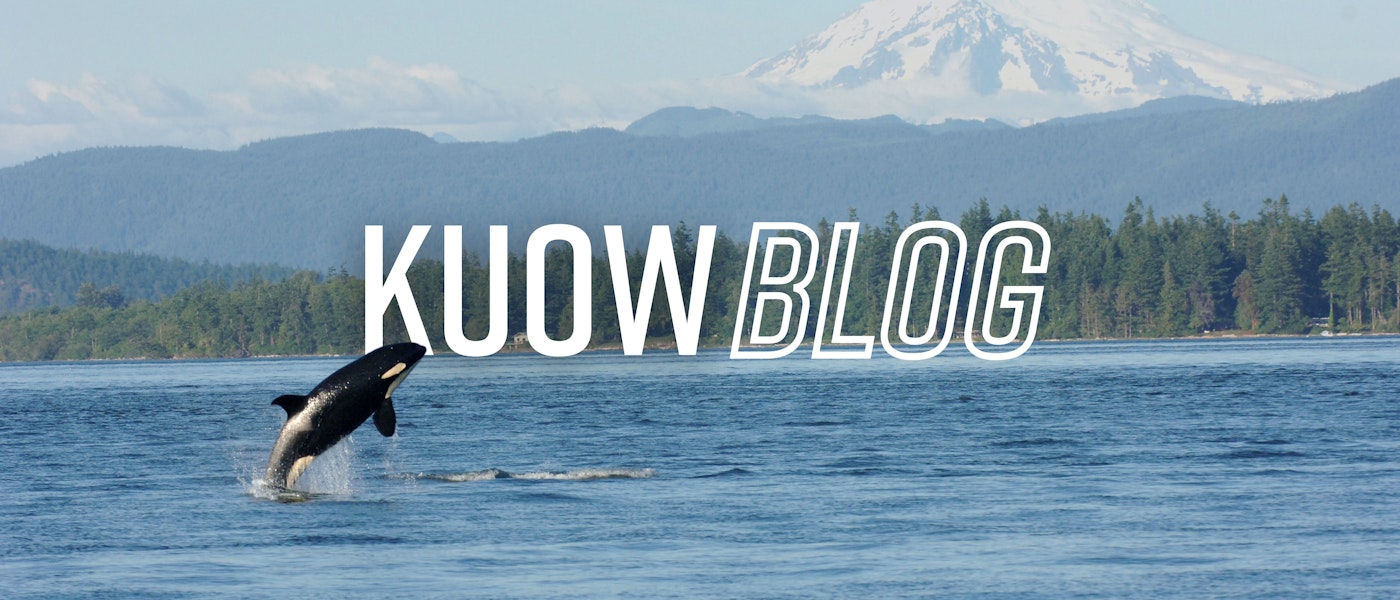

KUOW Blog
News, factoids, and insights from KUOW's newsroom. And maybe some peeks behind the scenes. Check back daily for updates.
Have any leads or feedback for the KUOW Blog? Contact Dyer Oxley at dyer@kuow.org.
Stories
-
Here comes the sun ... at 7 p.m. in Seattle!
Environment
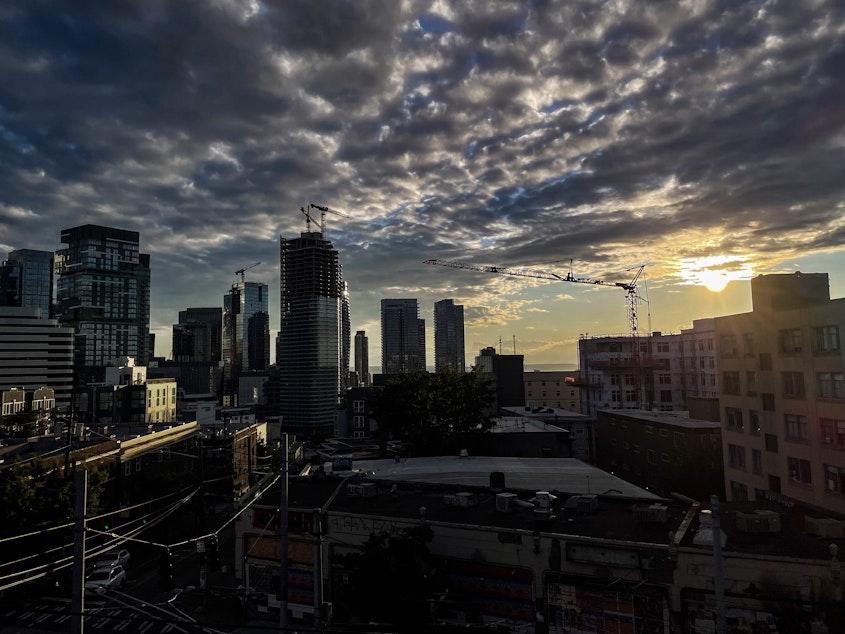 Sunset over Seattle captured in Capitol Hill. When daylight saving time kicks in on March 10, 2024, Seattle will have sunsets after 7 p.m.KUOW/Juan Pablo Chiquiza
Sunset over Seattle captured in Capitol Hill. When daylight saving time kicks in on March 10, 2024, Seattle will have sunsets after 7 p.m.KUOW/Juan Pablo ChiquizaWhat could be better than this week's sunny conditions around Seattle? Try sunlight that sticks around until 6:04 p.m.
That's when the sun will set on Thursday, March 7, signaling the beginning of the end of the Big Dark. But it gets better! Come next week, the sun will stick around until after 7 p.m.
RELATED: Permanent Daylight Saving Time is bad for your health, says UW expert
That's because daylight saving time begins Sunday, March 10, at 2 a.m.
The lasting evening light comes with a tradeoff. When daylight saving time kicks in Sunday, we'll get more light in the evenings and darker mornings until we turn the clocks back again in November.
So, as you prepare to reset any clocks that cannot do it themselves — because isn't the real offense watching the clock on your smartphone to make sure it's in sync with your microwave — here are a few things to keep in mind.
Continue reading » -
El Niño is 'on the wane.' What is in the forecast for Washington?
Washington's mountains have been watched closely this winter as snowpack has struggled to build in many parts of the state. But the season is already changing, and forecasters are looking ahead to the summer and even next winter.
“We're not going to have the same kind of weather that we had at the end of February into March, in which there was some really good growth for our snowpack … but it's going to be warmer," Washington state Climatologist Nick Bond told KUOW's Angela King. "I don't think there's much of a chance of a full recovery of the snowpack [for the rest of 2024].”
RELATED: U.S. hydropower drops to 20-year low as Northwest snowpack shrinks
The recent snow that hit Washington's mountains has been beneficial, but Bond says the region's snowpack is "not out of the woods yet."
Washington state's snowpack is roughly at 70% of normal, at this point. That depends on where you look around the state, however. The Olympic Mountains, for example, are at about half the normal level of snowpack. Part of the blame belongs to the El Niño climate pattern we're currently in — when conditions are generally warmer and drier than normal, especially in late winter.
“For what it's worth, this El Niño is on the wane and it looks like by the end of spring, we're going to be in neutral conditions in the tropical Pacific," Bond said, adding that looking further into the future, it's quite possible that we'll have La Niña conditions, yet again.
We just had three La Niñas in a row, which is quite rare.
"During La Niña winters, especially latter part, it tends to be on the cool side and sometimes wetter, leading to better snowpacks. If we can get through the summer without too many problems, maybe we'll get a reprieve.”
Snow in the mountains is essentially Washington's summer water supply — it melts and sends water downstream to communities throughout the state. At this point, it's expected that parts of the state will be in good shape over the summer, when it comes to water supply. The major cities should be OK. In other areas, irrigation and water rights could be an issue, Bond says, and many streams may be too low for comfort for trout and salmon.
Continue reading » -
$32.7M slated for asylum-seekers flowing into Washington state
Government
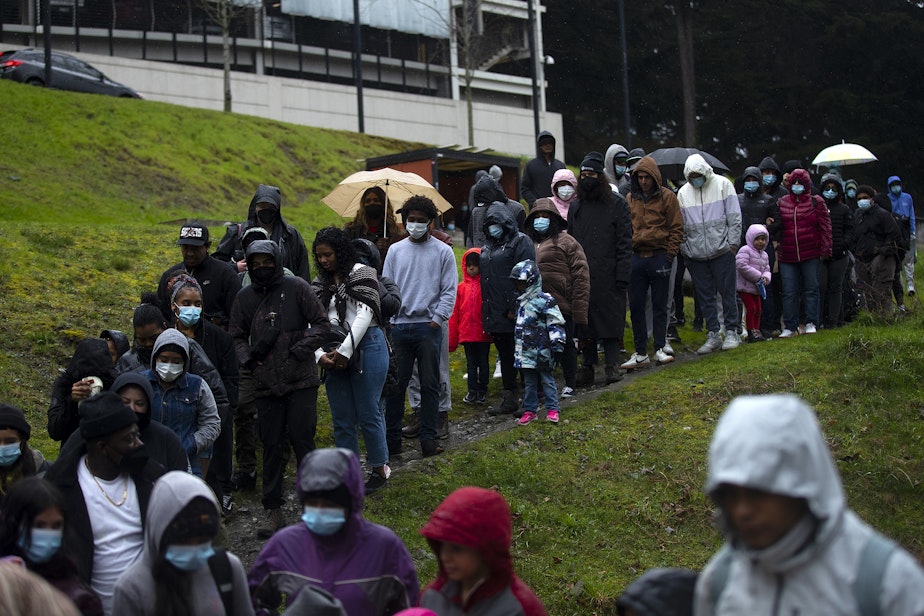 Asylum seekers once housed at the Sleep Inn in SeaTac, march to Seattle City Hall along with activists, mutual aid organizations and allies to ask for assistance with housing from Seattle city councilmembers on Tuesday, February 27, 2024, in Seattle.KUOW Photo/Megan Farmer
Asylum seekers once housed at the Sleep Inn in SeaTac, march to Seattle City Hall along with activists, mutual aid organizations and allies to ask for assistance with housing from Seattle city councilmembers on Tuesday, February 27, 2024, in Seattle.KUOW Photo/Megan FarmerAs legislators in Olympia move closer to finalizing the state’s next budget, they’ve designated $32.7 million for services to help an influx of asylum-seekers in Washington.
That state money will be used for housing, food programs, education and employment support, and services for children, among other things. Of that money, $7.5 million will be funneled through the Department of Commerce. The Department of Social and Health Services, which houses the state’s Office of Refugee and Immigrant Assistance, will receive $25.2 million.
RELATED: Tukwila is swelling with asylum-seekers. Will you house a family?
Those funds won’t be available until July, when the state’s 2024 fiscal year begins.
Sarah Peterson, a coordinator with the Office of Refugee and Immigrant Assistance, said she’ll be holding meetings with community stakeholders and contracted organizations about how to best proceed with the funding once it becomes available.
RELATED: Facing another hotel eviction, Seattle area asylum-seekers lean on religious groups to foot the bill
“A critical piece of the work that we'll be doing is building services like pathways to immigration related legal services, or support for housing stabilization,” Peterson said. “But it's done in a way that all people can access, and that is done in collaboration with the community.”
Local governments like King County have also set aside some money to help these migrants. But local officials say they’re counting on more permanent solutions from the federal and state governments.
“One of the things that we often share with our counterparts in the federal government is that welcoming newcomers happens at the local level,” Peterson said.
RELATED: King County Council members push back on criticism over handling of asylum-seeker crisis
For months, religious, mutual aid, and groups run by asylum-seekers have built a patchwork of support to secure temporary shelter. They’ve called on local governments, including Seattle, King County, and Tukwila, for help.
Many of the asylum-seekers arriving in the Seattle area have gone through the U.S. immigration system and are waiting to receive work authorization. Those applicants can’t work until they get permits or they risk jeopardizing their immigration cases.
Continue reading » -
Washington holds first carbon auction of 2024, with program's future in doubt
Environment
 Steam and invisible, heat-trapping carbon dioxide billow from the Marathon Petroleum Corporation refinery in Anacortes, Washington, in April 2022.Courtesy Kathleen Lumiere
Steam and invisible, heat-trapping carbon dioxide billow from the Marathon Petroleum Corporation refinery in Anacortes, Washington, in April 2022.Courtesy Kathleen LumiereA ballot initiative aiming to stop Washington state from charging for carbon pollution is already reshaping the state’s carbon market.
The state held its first carbon auction of the year on Wednesday.
Uncertainty around the future of the state’s system for capping and making polluters pay for climate-harming pollution has already lowered what polluters and speculators are willing to pay for "carbon allowances."
Those allowances, required to emit large volumes of climate-harming pollution in Washington, are sold at confidential state auctions four times a year. In 2023, companies and organizations paid $2.2 billion for the right to keep polluting the climate.
RELATED: The future of Washington state's carbon auction may come down to gas prices
Since November, prices for those allowances, which can be traded by investors after being auctioned off by the state, have fallen from about $56 per metric ton of carbon dioxide to $35 a ton, according to Texas financial firm AEGIS Hedging.
“Washington State Ballot Initiative 2117 is having a significant impact on [Washington carbon allowance] pricing and will continue to impact the market through November,” according to an analysis by California-based energy-analytics firm cCarbon.
“Investors and smaller compliance entities are likely to avoid the [Mar. 6] auction due to the high risks,” cCarbon analyst Gabriel Stoltzfus wrote.
Lower auction prices on Wednesday would mean lower business expenses as well as less funding for various state programs aimed at reducing climate-harming emissions and helping communities adapt to extreme heat, flooding, and other climate-fueled disasters.
Initiative 2117 would repeal the 2021 law that created the state’s “cap-and-invest” program and prohibit any similar programs from being implemented in the future.
RELATED: Republicans, Democrats, carbon, and you: Debating Washington's cap and trade
Continue reading » -
An invasive species, on San Juan Island?
Environment
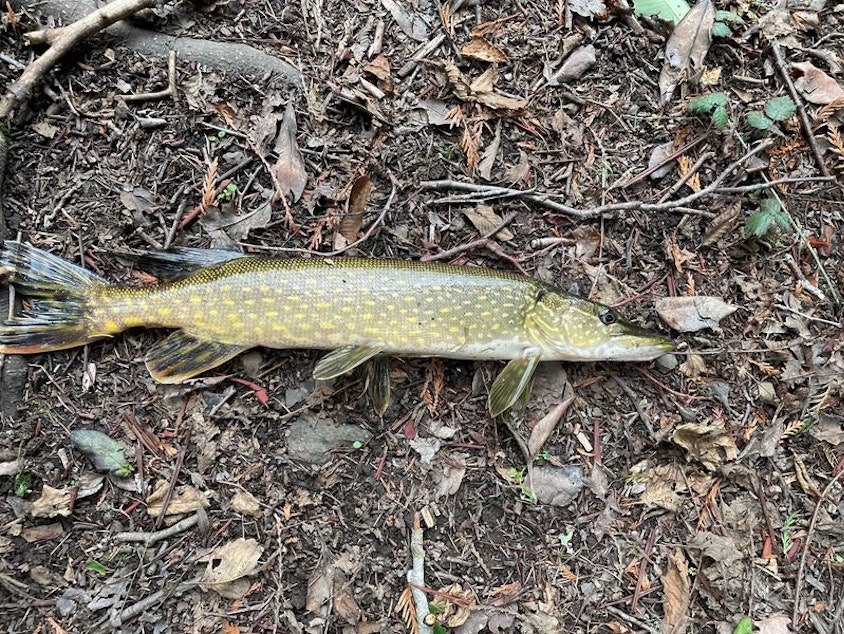 A northern pike fish caught in a pond on Limekiln Preserve on San Juan Island. The fish is an invasive species that Washington state wildlife officials have been watching out for.
A northern pike fish caught in a pond on Limekiln Preserve on San Juan Island. The fish is an invasive species that Washington state wildlife officials have been watching out for.Officials with the Washington Department of Fish and Wildlife say that an invasive species was "almost certainly" placed in local waters in violation of state law.
An invasive northern pike was fished out of a pond at Limekiln Preserve on San Juan Island in late February. According to a press release, it was caught by a local teenager who passed photos of the pike to local officials and the Washington Department of Fish and Wildlife.
RELATED: Washington watching for invasive species as it gets closer in Idaho
"WDFW is working with the Land Bank, county, and partners to deploy a rapid response to assess how many pike are in the area, and to remove them as soon as possible before they can spread to other waterways," the department said in a statement.
The San Juan County Conservation Land Bank reports that a skiff has been placed on the pond, where officials will be deploying gill nets. The WDFW says the fish is a threat to amphibians, birds, mammals, and other wildlife in the region.
The pike sighting on San Juan Island comes as WDFW has a draft plan under review, aiming to coordinate efforts to combat the invasive species.
“This plan is important to conservation in our state as it maps out the response of WDFW and coordinating partners to a number of situations that could arise with the spread of northern pike,” said Justin Bush, aquatic invasive species policy coordinator with WDFW, in a statement. “It will help to speed our response when timing is critical as partnering agencies and groups will already know their role and be prepared to respond.”
WDFW Eastern Region Fish Program Manager Chris Donley further notes that northern pike is likely to expand into waters across Washington state. They can live up to 20 years and produce a lot of young.
“Preventative work done now will help to minimize the environmental, economic, and cultural resource impacts of northern pike later," Donley said.
For a few years, state wildlife officials have been on guard for the northern pike in local waters. The fish is native to the Midwest, Canada, and parts of Alaska, but over the past decades, anglers have been known to transport the fish to non-native waters. That way, they can fish locally for them. The pike, however, can wreak havoc on local fish and wildlife populations. Washington bans any transport of pike into local waters.
"The pike [on San Juan Island] was almost certainly introduced in violation of state laws concerning prohibited species which ban their transport, sale, or introduction into state waters," WDFW said in its statement. "Violators face a maximum penalty of one year in jail and $5,000 in fines."
These fish are known for their sharp teeth and aggressive character. That means they threaten other fish species in the region, particularly Washington's beloved salmon.
RELATED: Can’t we just eat those invasive crabs until they’re gone? (Probably not)
Northern pike have shown up in Washington's lakes and rivers in recent years, prompting anxiety among wildlife officials and local tribes. There are northern pike in the Columbia River, which are currently trapped behind the Grand Coulee Dam. The fear is that these fish will make it past the damn and threaten salmon down stream.
If you come across an invasive species yourself, WDFW asks that you report it as soon as possible.
Continue reading » -
‘It’s not going to be The Dukes of Hazzard.' Police welcome flexibility on pursuits, critics fear more crashes
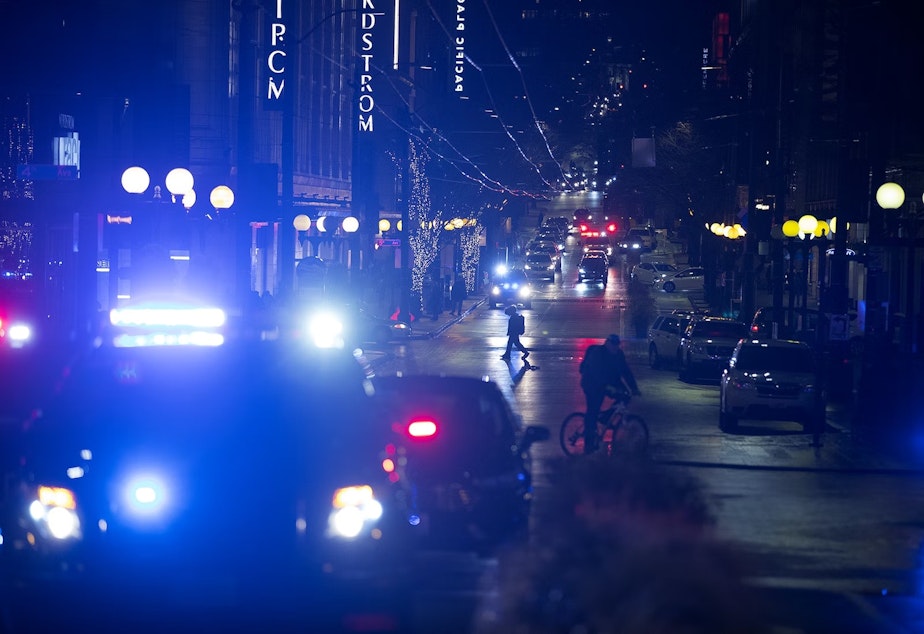 Patrol cars and ambulances are shown at the intersection of Third Avenue and Pine Street on Wednesday, Jan. 22, 2020.KUOW Photo/Megan Farmer
Patrol cars and ambulances are shown at the intersection of Third Avenue and Pine Street on Wednesday, Jan. 22, 2020.KUOW Photo/Megan FarmerLaw enforcement groups are praising Washington lawmakers for passing an initiative granting local agencies more flexibility for police vehicle pursuits. They say the change will help police address rising crime and reckless driving.
Meanwhile, a national policing group recommends restricting police pursuits to cases of violent crime, where the suspect poses an imminent threat, a standard closer to Washington’s current law.
Legislators voted to approve I-2113 on Monday. The Republican-backed measure, which takes effect on June 6, does away with statewide pursuit restrictions put in place since 2021, which limit pursuits to specific violent crimes where the fleeing person poses a serious risk of harm. Instead the initiative lets local agencies decide when to chase fleeing vehicles, if someone is suspected of breaking the law while posing a safety threat.
RELATED: Washington police pursuit rules to change after Legislature adopts 3 voter initiatives
Steve Strachan is executive director of the Washington Association of Sheriffs and Police Chiefs, which supported the initiative. He said the flexibility will help police address increased crime and traffic fatalities.
“This will hopefully start to send a stronger message that criminals don’t have the upper hand, that they can’t just drive away with no consequence, but this is going to be a transition and certainly I think every agency is looking at their policies,” he said.
Strachan said pursuits are inherently dangerous and he wants legislators to help address fleeing suspects through other measures like tougher penalties, impounding vehicles, and increased use of technology. He said he was frustrated that a bill containing those provisions failed this year.
“We hope that the eventual result is not more pursuits, but less pursuits,” he said.
Strachan said it will take time for the public to notice any changes.
“You know, it’s not going to be 'The Dukes of Hazzard' out there,” he said.
RELATED: Police vehicle pursuits mostly on pause in Seattle due to lack of training
But Leslie Cushman with the Washington Coalition for Police Accountability said that’s her biggest fear about the implications of giving police more leeway.
Continue reading » -
Got long Covid? UW Medicine wants to hear from you
Health
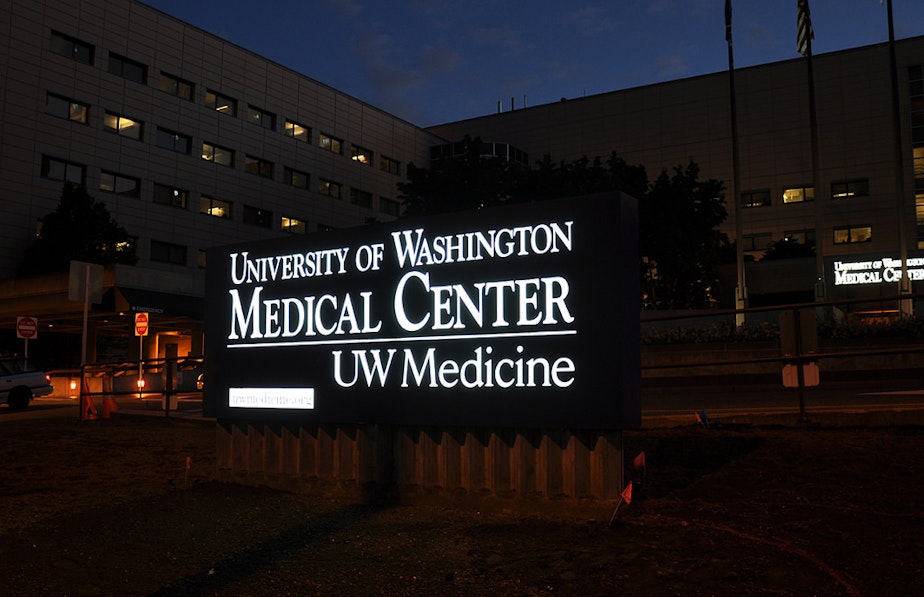 University of Washington Medical Center
University of Washington Medical CenterSeattle is among a handful of cities chosen for studies to evaluate long-Covid therapies.
University of Washington Medicine announced Wednesday it will conduct the first two clinical trials to study long Covid for the National Institutes of Health. The clinical trials are part of the NIH RECOVER Initiative (RECOVER stands for Researching Covid to Enhance Recovery).
RELATED: Long Covid, long wait times: patients turned away from specialty clinics turn to primary care docs
Some people who have had Covid-19 may experience long-term impacts from the infection. For some, the condition's symptoms can last months or even years. UW Medicine reports that symptoms can vary, but some of the most commonly reported problems include fatigue, brain fog, low physical endurance, trouble with problem-solving, and memory lapses.
Dr. Helen Chu will lead the research team. Chu is an expert in communicable respiratory diseases and is a professor of medicine at the University of Washington School of Medicine.
Researchers expect the trials to last until December. They plan to enroll 315 total participants across all study sites in the U.S. The UW team will enroll 25 participants and then continue to enroll more people until the nationwide goal of 315 participants is met.
Several studies will be conducted nationwide to assess potential therapies, including drugs, and even medical devices to help alleviate long Covid symptoms. Anyone interested in the clinical trials can learn more by sending an email to uwrecoverstudy@uw.edu.
RELATED: Extreme heat can exacerbate long Covid symptoms
Continue reading » -
Tukwila is swelling with asylum-seekers. What can be done?
Government
 Rita Kuemba of Angola holds hands with her 6-year-old son, Wilson Pedro, while helping to set up tents outside of the Riverton Park United Methodist Church, where nearly 200 people are sheltering while seeking asylum, on Monday, October 16, 2023, in Tukwila.KUOW Photo/Megan Farmer
Rita Kuemba of Angola holds hands with her 6-year-old son, Wilson Pedro, while helping to set up tents outside of the Riverton Park United Methodist Church, where nearly 200 people are sheltering while seeking asylum, on Monday, October 16, 2023, in Tukwila.KUOW Photo/Megan FarmerWhen asylum-seekers began showing up at the door of Tukwila's Riverton Park United Methodist Church last year, Rev. Jan Bolerjack felt it was the church's duty to care for them. But as the situation worsened over the months, the reverend said it's now more than one church, in one Washington town, can handle.
"This basically came to us, and we couldn't shut the door," Bolerjack told KUOW's Soundside. "It is our call; this is more than we can handle though."
The reverend said that the need is now so great, she has to turn some people away. The issue has grown into a regional emergency, with various parties chipping in to help, but with few long-term solutions.
RELATED: Tukwila church offers temporary comfort and refuge for asylum seekers
Bolerjack is now urging others in Western Washington to help. She hopes people will open their homes.
"They can come and take a family into their homes. These families are wonderful families," she said. "They deserve better than what they are getting as a welcome into the United States. Some people even wonder if they are really in the United States, ending up like they are here. Come take a family. Come meet a family. Come play with some children. Financial assistance is always welcome, also."
"I got a call from a friend, Sarah Perry, who is also our King County Council member, and asked if MAPS could help with a situation they have," said Hyder Ali with MAPS.
Ali said that he was told the asylum seekers needed a place to stay for about two weeks. He turned around and spoke with the MAPS board and within 10 minutes, the funding was approved.
"Migrants are probably the most vulnerable in our society," Ali said. "No one wants to uproot their family and come to a foreign country, unless they face severe violence or disastrous conditions in their homeland. In the Muslim community we are quite familiar with this situation because we've had a number of refugees from war-torn countries that have come to Seattle ... our faith teaches us that we need to take care of the most vulnerable."
Continue reading » -
Corner stores are the cornerstone of Seattle's quest to become a 15-minute city
Government
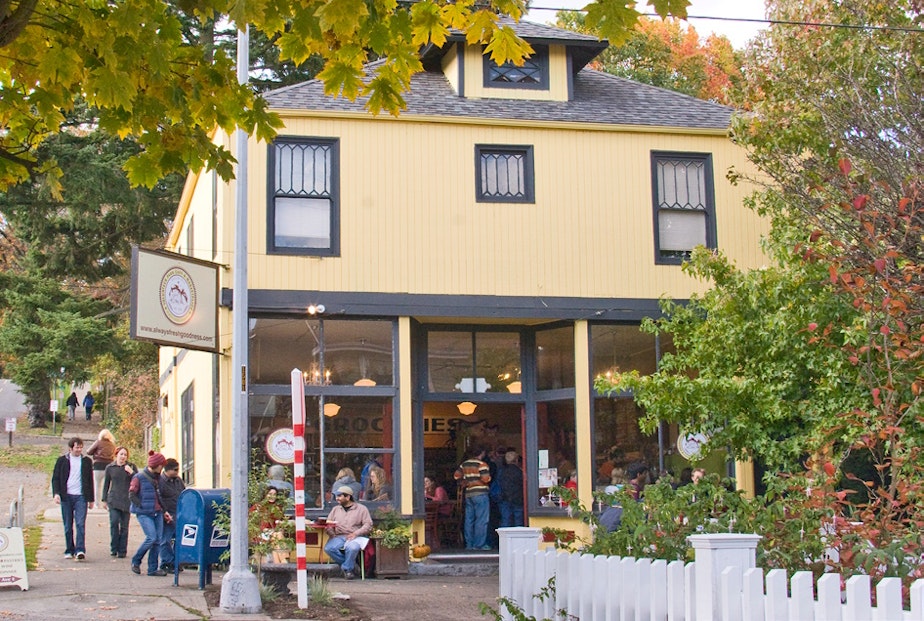 The Volunteer Park Cafe, as seen in a report associated with the City of Seattle's comprehensive plan update, serves as a model for what legalized corner stores could look like.City of Seattle
The Volunteer Park Cafe, as seen in a report associated with the City of Seattle's comprehensive plan update, serves as a model for what legalized corner stores could look like.City of SeattleA "15-minute city" is a city where the shops and restaurants you need are within a 15-minute walk of your home. That is Seattle's goal.
The city's new draft comprehensive plan includes a proposal to achieve that status, in part by reviving neighborhood corner stores.
The plan comes shortly after the death of a bill in Olympia that would have legalized corner stores statewide.
I
f you’ve walked through Seattle’s residential neighborhoods, you may have seen funky, older homes that look like they used to be restaurants or corner stores. They’re remnants of an era when homes and businesses used to butt up against each other.
Of the businesses that managed to hold on to old corner store locations, many have become beloved neighborhood institutions, like the Volunteer Park Cafe or Irwin's in south Wallingford.
But these survivors have been swimming against the tide. After World War II, Seattle, like many cities, decided homes and businesses should be kept apart.
But in low density zones, the clues of an earlier way of thinking are still there. Maybe a home has a big plate glass window right next to the sidewalk (with the windows drawn) — or a strange entry door diagonally situated, facing the street corner where sidewalks cross. These tell the story of a time when stores were within a short walk of every home.
In the years since corner stores fell out of favor, the economics of what will succeed in those spaces has changed. Today, large grocery chains negotiate special discounts on goods that put smaller grocery stores at an economic disadvantage.
This is one reason why many business locations evolved into awkward homes, where residents must keep the shades drawn to get a little privacy from passersby on the sidewalk.
RELATED: Will Seattle's new growth plan produce enough housing for newcomers?
Current zoning laws make it difficult to turn those homes back into businesses in low density residential neighborhoods. But Seattle's new draft comprehensive plan, released Tuesday, would allow those awkward apartments to become businesses again. It would also allow construction of new corner stores, though city officials say that will probably not happen often, for economic reasons.
Nevertheless, the new approach suggests that in the future, it’ll be easier for people to find hidden cafes and shops nestled among smaller homes.
Continue reading » -
King County leaders say they have new plans to fight the opioid crisis. But when?
Health
 King County Executive Dow Constantine stands with members of the County Council and public health community at a press conference on Monday, March 4, 2024.KUOW Photo/ Casey Martin
King County Executive Dow Constantine stands with members of the County Council and public health community at a press conference on Monday, March 4, 2024.KUOW Photo/ Casey MartinKing County officials announced new plans to address the region's opioid crisis Monday, aiming to provide new avenues to help people who are addicted to dangerous drugs. None of the plans involve new funding and it’s uncertain when they might materialize.
At a press conference, King County Executive Dow Constantine announced new plans to stop people from dying from drug overdoses. The broad-ranging plans cover mental and behavioral health, mobile outreach, overdose treatment, and more services for young people addicted to drugs.
“Substance use disorder is complex, and there is not one single cause, nor one simple solution,” Constantine said.
RELATED: Fentanyl is a great drug for cartels. But those blue pills are killing King County
Aiming to address the multiple causes, the new plan includes:
- King County will partner with Pioneer Human Services to open a treatment program in Seattle with room for 16 people.
- The County also intends to re-open a 24-hour sobering center downtown.
- Fire departments in the county will get more nalaxone to give out to people. The nasal spray stops the effects of an opioid overdose and can save someone’s life.
- Public health officials also want to test up to 1,000 drug samples a year to cut cut down on the fentanyl in the county.
To do all of this work, county officials said it will hire dozens of people to work in substance abuse treatment, case management, and behavioral and mental health care. They’ll also add about 50 apprenticeships to attract new people into the field.
All of these plans will be paid for by existing taxes and initiatives already approved by King County voters. No new money will be allocated to this project, elected leaders said.
When exactly any of this will happen is unknown. Neither Executive Constantine nor anyone else at the press conference would specify a timeline. Clint Jordan of Pioneer Human Services, however, did comment on when a 16-bed residential treatment program could open.
"We’re targeting a six month open,” Jordan said. “I think that puts us in October, November, somewhere in there.”
The multi-pronged approach is an effort to reach as many people as possible as opioid use, especially fentanyl, is surging in King County. Seattle-King County Public Health reports a record 1,082 people died last year from overdoses. Just over two months into 2024, there already have been 134 people in King County who have died from an opioid overdose.
Continue reading » -
Seattle cop slashes minivan tire during pro-Palestine march, video shows
 A video on Instagram shows what appears to be a Seattle officer deflating the tire during a march last month.
A video on Instagram shows what appears to be a Seattle officer deflating the tire during a march last month.A Seattle police officer is under investigation for allegedly slashing a tire during a pro-Palestine march last month, according to the Office of Police Accountability. The march was held on Feb. 9, in downtown Seattle, and had reached the World Trade Center along the waterfront when the incident took place.
A video circulating on social media shows a beige minivan pulling away, as protestors chant in the background. One officer gestures for the car to move forward. Another Seattle officer then runs up behind the vehicle and appears to plunge some kind of device into the driver’s rear tire.
A different clip shows an officer placing what appears to be a stationary tire deflation device near the minivan’s front passenger tire. Seattle Policy policy allows for the use of stationary tire deflation devices, but only when the vehicle is not moving.
Continue reading » -
Seattle area McClatchy newspapers move to printing just 3 days per week
Business
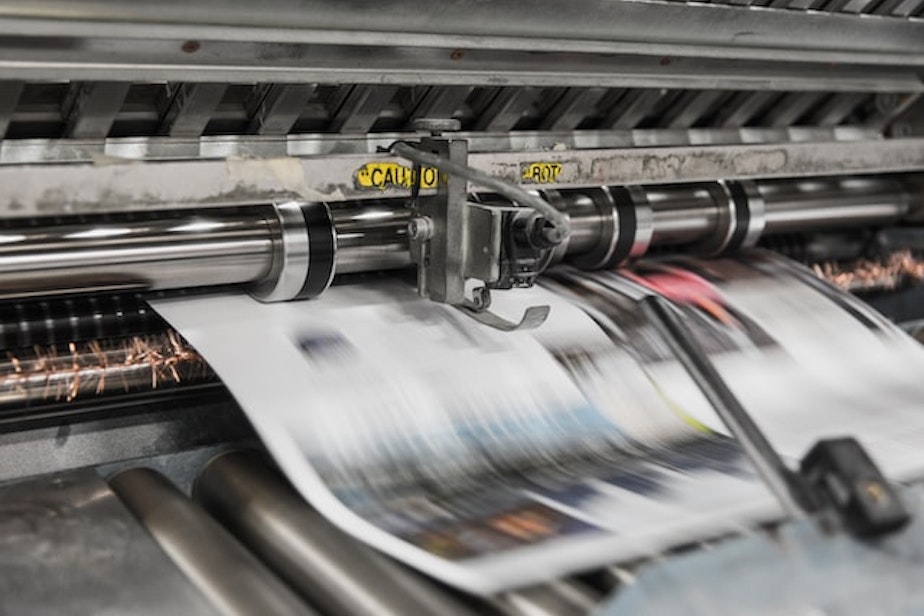
The McClatchy Media Network is planning a digital transformation for two of its regional newspapers to better align with how readers are getting their news in 2024.
In a statement published by the Tacoma News Tribune and The Olympian last week, both news outlets said they’ll move to a digital-first news format, and only provide print versions of their papers three days a week, every Wednesday, Friday, and Sunday starting May 6. The digital versions of the papers will be called eEditions and will include websites and mobile apps.
In January, the McClatchy-owned Bellingham Herald also moved to a more digitally-focused format, printing just twice a week to better serve the growing number of people using their phones or other smart devices to consume news.
According to a 2023 Pew Research study, 86% percent of adults in the U.S. get their news from a smartphone, tablet, or computer.
Continue reading »
